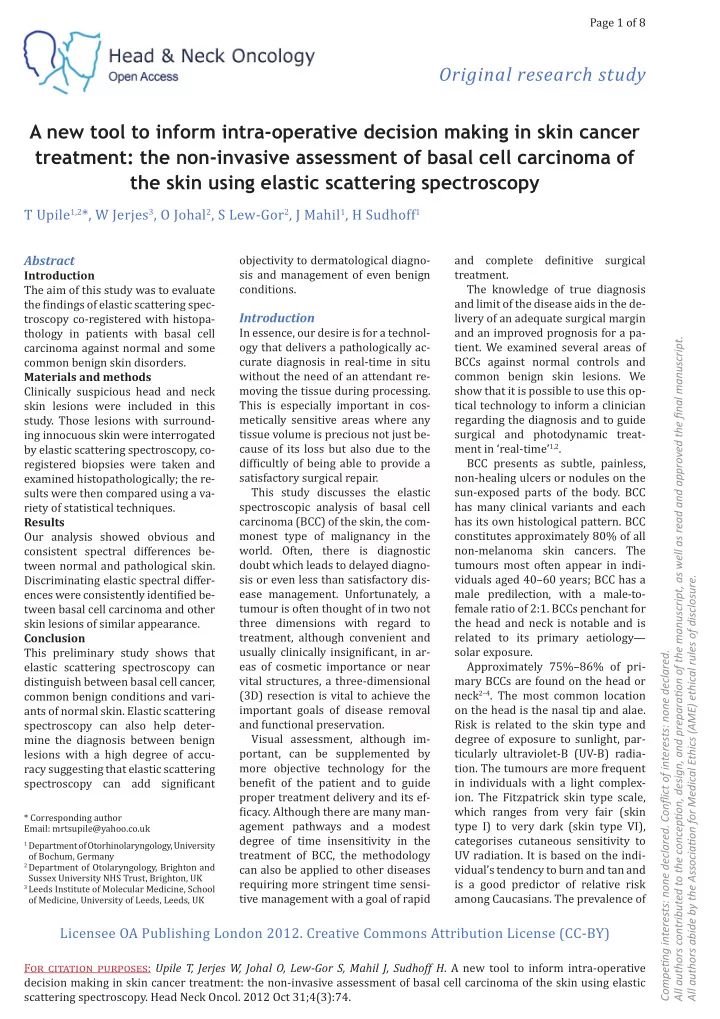

Page 1 of 8 Original research study A new tool to inform intra-operative decision making in skin cancer treatment: the non-invasive assessment of basal cell carcinoma of the skin using elastic scattering spectroscopy T Upile 1,2 *, W Jerjes 3 , O Johal 2 , S Lew-Gor 2 , J Mahil 1 , H Sudhoff 1 Abstract objectivity to dermatological diagno - and complete definitive surgical sis and management of even benign treatment. Introduction conditions. The knowledge of true diagnosis The aim of this study was to evaluate and limit of the disease aids in the de - the findings of elastic scattering spec - Introduction livery of an adequate surgical margin troscopy co-registered with histopa - In essence, our desire is for a technol - and an improved prognosis for a pa- thology in patients with basal cell All authors contributed to the conceptjon, design, and preparatjon of the manuscript, as well as read and approved the fjnal manuscript. ogy that delivers a pathologically ac - tient. We examined several areas of carcinoma against normal and some curate diagnosis in real-time in situ BCCs against normal controls and common benign skin disorders. without the need of an attendant re - common benign skin lesions. We Materials and methods moving the tissue during processing. show that it is possible to use this op - Clinically suspicious head and neck This is especially important in cos - tical technology to inform a clinician skin lesions were included in this metically sensitive areas where any regarding the diagnosis and to guide study. Those lesions with surround - tissue volume is precious not just be - surgical and photodynamic treat - ing innocuous skin were interrogated cause of its loss but also due to the ment in ‘real-time’ 1,2 . by elastic scattering spectroscopy, co- difficultly of being able to provide a BCC presents as subtle, painless, registered biopsies were taken and satisfactory surgical repair. non-healing ulcers or nodules on the examined histopathologically; the re - This study discusses the elastic sun-exposed parts of the body. BCC sults were then compared using a va - spectroscopic analysis of basal cell has many clinical variants and each riety of statistical techniques. carcinoma (BCC) of the skin, the com - has its own histological pattern. BCC Results monest type of malignancy in the constitutes approximately 80% of all Our analysis showed obvious and world. Often, there is diagnostic non-melanoma skin cancers. The consistent spectral differences be - doubt which leads to delayed diagno - tumours most often appear in indi - tween normal and pathological skin. sis or even less than satisfactory dis - viduals aged 40–60 years; BCC has a Discriminating elastic spectral differ- All authors abide by the Associatjon for Medical Ethics (AME) ethical rules of disclosure. ease management. Unfortunately, a male predilection, with a male-to- ences were consistently identified be - tumour is often thought of in two not female ratio of 2:1. BCCs penchant for tween basal cell carcinoma and other three dimensions with regard to the head and neck is notable and is skin lesions of similar appearance. treatment, although convenient and related to its primary aetiology— Conclusion usually clinically insignificant, in ar - solar exposure. This preliminary study shows that Competjng interests: none declared. Confmict of interests: none declared. eas of cosmetic importance or near Approximately 75%–86% of pri - elastic scattering spectroscopy can vital structures, a three-dimensional mary BCCs are found on the head or distinguish between basal cell cancer, (3D) resection is vital to achieve the neck 2–4 . The most common location common benign conditions and vari - important goals of disease removal on the head is the nasal tip and alae. ants of normal skin. Elastic scattering and functional preservation. Risk is related to the skin type and spectroscopy can also help deter - Visual assessment, although im - degree of exposure to sunlight, par - mine the diagnosis between benign portant, can be supplemented by ticularly ultraviolet-B (UV-B) radia - lesions with a high degree of accu - more objective technology for the tion. The tumours are more frequent racy suggesting that elastic scattering benefit of the patient and to guide in individuals with a light complex - spectroscopy can add significant proper treatment delivery and its ef- ion. The Fitzpatrick skin type scale, ficacy. Although there are many man - which ranges from very fair (skin * Corresponding author agement pathways and a modest type I) to very dark (skin type VI), Email: mrtsupile@yahoo.co.uk degree of time insensitivity in the categorises cutaneous sensitivity to 1 Department of Otorhinolaryngology, University treatment of BCC, the methodology UV radiation. It is based on the indi - of Bochum, Germany 2 Department of Otolaryngology, Brighton and can also be applied to other diseases vidual’s tendency to burn and tan and Sussex University NHS Trust, Brighton, UK requiring more stringent time sensi - is a good predictor of relative risk 3 Leeds Institute of Molecular Medicine, School tive management with a goal of rapid among Caucasians. The prevalence of of Medicine, University of Leeds, Leeds, UK Licensee OA Publishing London 2012. Creative Commons Attribution License (CC-BY) For citation purposes: Upile T, Jerjes W, Johal O, Lew-Gor S, Mahil J, Sudhoff H . A new tool to inform intra-operative decision making in skin cancer treatment: the non-invasive assessment of basal cell carcinoma of the skin using elastic scattering spectroscopy. Head Neck Oncol. 2012 Oct 31;4(3):74.
Recommend
More recommend